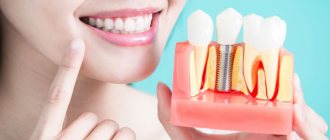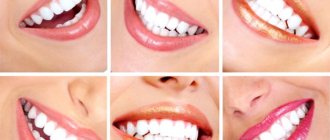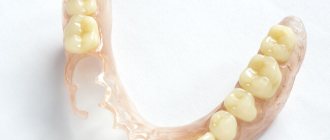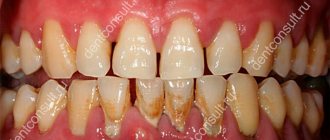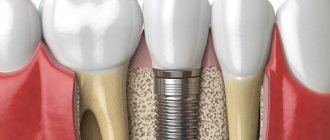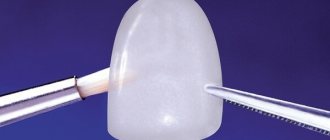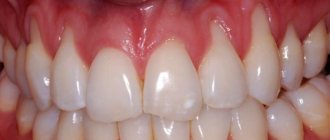From this article you will learn:
- What are lumineers - before and after photos.
- cost for 2022 in Moscow,
- veneers or lumineers: which is better?
Lumineers™ are ultra-thin ceramic veneers that are bonded to the front surfaces of teeth to improve their appearance without requiring the removal of tooth enamel. Lumineers were developed in the United States of America by DenMat. This unusual name is now trademarked, so no other company can call their ultra-thin veneers "Lumineers™" - even if they have exactly the same characteristics.
There are 2 types of original lumineers - Lumineers® CERINATE and Lumineers® DUO. The first ones are of higher quality, because They are made individually based on an impression of the patient’s teeth. For such lumineers, the price for 1 tooth in Moscow will average from 60,000 rubles. The second option is the so-called “Lumineers for the poor”, the cost of which in dentistry will be 2 times lower. In this case, ready-made lumineers sets are installed on the teeth, which are available in several colors and sizes. And before fixing them, the doctor will adapt them to your teeth (file them).
Ultra-thin veneers without grinding teeth: photo
You must understand that Lumineers are not the only very thin veneers of their kind, and are simply a proprietary trade name. Therefore, when you even hear about thin veneers or ultra-veneers, they are all the same as the original Lumineers®. As you will see below, reviews of original lumineers are rarely positive, unless, of course, you have high aesthetic requirements. And here the high price should not mislead you into thinking that you will get truly Hollywood veneers.
There are very thin veneers available under other brands, most notably very thin glass-ceramic veneers IPS-Emax®. Other brands are Vivaneers® and DaVinci®. In this article we will not engage in advertising, and will show you photos and videos of patients after installation of lumineers, so that you can form your own idea.
Veneers or Lumineers: which is better to choose?
So, what is the difference between veneers and lumineers? Firstly, according to advertising, original lumineers have a thickness of only 0.2 mm, which makes it unnecessary to grind off the enamel from the front surface of the teeth. Firstly, this is not entirely true, because... the manufacturer’s official instructions indicate a more plausible thickness – “0.3-0.7 mm”. Moreover, you can expect a thickness of 0.3-0.4 mm only from Lumineers® CERINATE, i.e. This is an option for custom-made lumineers.
If you think that by gluing a layer of only 0.2-0.3 mm to the surface of the tooth, it will not be noticeable - you are mistaken. In fact, even this thickness will greatly increase the size of the teeth. Therefore, if you have large teeth, then even the thinnest lumineers or veneers will make them really “horse-like.” And therefore, when in advertising they talk about “unnecessary grinding of teeth”, this is just a marketing ploy. In fact, this is only possible in patients with small teeth and wide interdental spaces.
For Lumineers® DUO (ready-made veneers), the thickness will be already 0.6-0.7 mm, which in principle corresponds to the thickness of classic ceramic veneers and always requires grinding off the enamel layer on the front surface of the teeth. Otherwise, you will have very large, massive teeth. By the way, we already said above that other companies also produce ultra-thin veneers. There are several brands, but the best, in our opinion, are ultra-thin Emax pressed glass ceramic veneers (they are also only 0.3-0.4 mm thick).
What is the difference between veneers and lumineers –
Pay attention to the photo below. Classic ceramic veneers have a thickness of 0.6 mm (a little more at the cutting edge - 0.7 mm). In turn, thin veneers, by which we mean both classic Lumineers® and pressed glass-ceramic Emax, have the same thickness of 0.3-0.4 mm.
Conclusions: but then you get veneers and lumineers - what is the difference? When buying original lumineers, the cost of which ranges from 30,000 to 60,000 rubles (for 1 unit), you are buying exclusively the brand and the advertising slogan “no grinding of teeth.” But again, the statement that it is unnecessary to grind teeth under lumineers is a very controversial point, and this is possible only in the rarest cases. As you will see in the before and after photos below, increasing the thickness of the teeth by just 0.2-0.3 mm without grinding them down significantly increases the size of the teeth.
A thin veneer made of pressed glass ceramics E.max will cost you from 21,000 rubles, and at the same time it has the same thickness. Manufacturer E.max (Ivoclar Vivadent, Germany) - in this case, it could also say that there is no need to grind the teeth, but due to professional ethics, it does not do this. Below you can see how, after fixing lumineers without grinding the teeth, the latter look like giant plastic crowns (although later we will show you several cases of successful use of lumineers).
Comparison of original Lumineers and Emax (video) –
Video 1 – original Lumineers® CERINATE, video 2 – thin E.max veneers (without grinding teeth).
As for the strength of lumineers, the original Lumineers® are made from Cerinate brand porcelain with a bending strength of about 110 MPa. Porcelain is nothing more than feldspathic ceramics. In turn, the bending strength of thin veneers made of pressed ceramic E.max PRESS will be about 400 MPa. This affects the risk of chipping of the ceramic mass and service life. In principle, after this, as a dentist, I simply have nothing special to add, and indeed, when Emax ceramics first appeared, for us dentists it was really a revolution in the class of materials.
Lumineers for teeth: indications for use
Due to their small thickness, fragility, and high transparency, lumineers on teeth have a fairly large number of contraindications (the list of which is even longer than that of conventional veneers). Therefore, during the initial examination, the dentist will look at whether veneers or lumineers are better in relation to your situation. The list of indications for lumineers is quite modest, and each indication also has a lot of restrictions related to the size of the teeth, gum inflammation, etc.
- Masking stains and cracks on enamel, fillings - we are talking about color disturbances that cannot be neutralized with chemical bleaching. These may be small stains, enamel cracks or fillings that are visible against the background of the tooth’s own tissues. High-quality lumineers should a priori be quite transparent, and therefore they are not suitable for masking bright spots. And if you make them opaque, they will look more like bright white plastic than natural tooth enamel.
- Correcting minor bite problems - firstly - they will close small gaps between teeth, for example, diastema. Secondly, if the teeth are located unevenly in the dentition, they can be used to achieve the effect of visual alignment of the dentition (this occurs due to the fact that when installing lumineers on only some teeth, they will increase the thickness of these teeth).
- Teeth lightening – with the help of lumineers you can visually lighten your teeth by 1-2 shades. It is possible, but it is still better to do this using chemical bleaching - it will be both more effective and cheaper.
Important: as you already understand, the use of lumineers will only be effective for eliminating minor aesthetic problems in the front teeth. To eliminate pronounced problems: bright spots, wide interdental spaces, chipped cutting edges, to change the inclination of the tooth, etc. – veneers of standard thickness should be used.
Lumineers: before and after photos
Below you can see what Lumineers look like before and after – photos of real patients. In this section we have published photos of the most successful cases of treatment. Below (in the “Reviews” section) you can also see photos of not very successful cases of treatment, when teeth began to look artificial and not natural (24stoma.ru).
Bottom line
Lumineers do not require special care, but they should be treated, just like your own teeth, with care and precision. Do not use them to open bottles or chew nuts or crackers that are too hard. Regular hygiene procedures are sufficient - 2 brushings a day and the use of an irrigator to remove food debris from the interdental spaces. It is better not to use dental floss, so as not to damage the thin lining.
Sources:
- https://MikDent.ru/protez/viniry/lyuminiry-chto-eto-takoe.html
- https://jsmiles.ru/estetika/7-viniry/42-luminiry/
- https://www.vash-dentist.ru/protezirovanie/nesemnyie-p/lyuminiryi/na-zubyi-opisanie-foto-do-i-posle-otzyivyi-plyusyi-i-minusyi.html
- https://24stoma.ru/lyuminiry-do-i-posle.html
- https://zubovv.ru/protezirovanie/nesemnyie-p/lyuminiryi/foto-do-i-posle-otzyivyi-plyusyi-i-minusyi-opisanie.html
- https://vproteze.com/lyuminiryi-na-perednie-zubyi.html
- https://protezi-zubov.ru/nakladki-na-zuby/ljuminiry/
- https://Denta.help/ortopedicheskaya/lyuminiry-na-zuby-1256
- https://CreateSmile.ru/ustanovka-lyuminirov/
- https://dentist-pro.ru/protezirovanie/nesemnye/lyuminiry/foto-do-i-posle-nyuansy-vybora-i-ustanovki.html
- https://zubovv.ru/protezirovanie/nesemnyie-p/lyuminiryi/tsena-za-1-zub.html
Lumineers: price for 1 tooth in Moscow
How much do lumineers cost? The price for 1 tooth will be from 30,000 to 60,000 rubles, if we talk about original products (USA). This company produces 2 versions of lumineers - Lumineers® CERINATE and DUO, which differ in price.
- Cost Lumineers® CERINATE are custom-made lumineers that are created from impressions of the patient's teeth.
Their cost will be from 50,000 to 70,000 rubles per 1 unit. This price includes manufacturing, installation and all associated costs except delivery. The cost of delivery (regardless of the number of lumineers) will be about another 40,000 rubles. Today, the American company DenMat produces Lumineers® CERINATE not only in its own laboratory in the United States, but also in 2 more laboratories, one each in Italy and Luxembourg. No other dental laboratory worldwide is authorized to produce such thin veneers under the Lumineers® brand.
- Cost Lumineers® DUO are no longer individually made, but sets of ready-made lumineers, available in several sizes and colors.
Looking at your teeth, the doctor will select the right headset option that will best suit your teeth. But in any case, you must understand that they will not fit your teeth exactly in shape, and therefore, after fixing them on your teeth, they will take a long time to grind with a drill, bringing them to perfection. Lumineers® DUO Lumineers are a hybrid of Cerinate porcelain and a composite filling material. In fact, they are no better than composite veneers costing 8,000-9,000 rubles, which are made entirely from light-polymer composite filling material. Their only advantage over individually made lumineers/thin veneers is the possibility of fixation immediately on the day of visiting the dentist.
- Thin veneers from E.max – pressed glass ceramics E.max is one of the best types of ceramics used in dentistry. This material closely matches natural tooth enamel in terms of optical properties, and therefore allows veneers or crowns made from this material to be given a very high level of aesthetics, which is simply unattainable with original Lumineers®. At the same time, the price for E.max is on average from 21,000 rubles (for 1 unit).
Type of thin E.max veneers – before and after photos
Manufacturer
Lumineers have been used in dentistry for more than two decades, but in Russia they have gained popularity since 2005. The manufacturer and patent holder of the production technology is the American company Cerinate.
Lumineers are made from ceramic with the addition of crystalline leucite, which gives the material excellent aesthetic characteristics. It does not contain metallic inclusions, which eliminates even the slightest reflection of light in the microprosthesis. Light can circulate and penetrate the adjustment freely, just like natural enamel. It is no coincidence that leucite is often used in jewelry making.
Ceramics for overlay lumineers, produced using Cerinate technology, are not only beautiful, but also have great mechanical strength. Original products are not susceptible to chipping or cracking, which ensures a long service life.
On a note!
The full composition and details of the technological process for producing “Hollywood ceramics” are kept secret.
Lumineers: reviews, clinical studies
Research shows that lumineers have a lifespan that is rarely comparable to the 15-25 year lifespan of conventional veneers. Several studies have shown that the lifespan of lumineers is usually less than ten years. However, all these studies were conducted in Europe and the USA, where the quality of medical care is disproportionately higher, and where patients are largely protected from situations where a doctor recommends a service, even seeing that it is not very suitable for the patient (for example, there is an increased risk of chipping ceramics).
In the United States, approximately only 5-6% of doctors use lumineers in their practice. The survey revealed the main reason - it is very difficult to restore aesthetics with the help of lumineers. The majority of American dentists surveyed in this study said that they simply could not achieve the same realistic, natural appearance of teeth with Lumineers that they could achieve with regular veneers.
Lumineers can be of different transparency. More transparent lumineers look natural on teeth, but do not mask tooth color problems well. More opaque lumineers are better at eliminating enamel color problems, but they give the teeth an absolutely unnatural appearance (Fig. 8-11), and a compromise here is difficult to achieve.
Lumineers: before and after photos
Advantages
The main advantages of this type of microprostheses are as follows.
- Safety
. Due to the very small thickness, there is no need to remove part of the tooth enamel for installation. This means that the teeth remain healthy and vibrant under the lumineers, so they can be removed at any time when needed. - Protection
. The installation technology involves a very tight fit of the lumineers plates to the surface of the enamel, thereby making them an additional protective layer. This ensures that germs cannot penetrate inside the tooth.Additional protection is the material used for fastening. It contains a high content of fluoride, which strengthens and heals teeth.
- Strength
.Photo: smile with lumineers | © elavuk81 / Fotolia
The material from which the records are made has enormous strength thanks to special technologies and the addition of special strength crystals.
- Life time
. Good fastening and durable material can extend the service life to 20 years or more. - Natural appearance
. Ceramics for making lumineers have many shades, and, in addition, it is possible to use special paints to create other shades in order to accurately match the lumineers to the natural color. - Painless installation
. Attaching lumineers does not cause discomfort or pain, since there is no need to grind down the enamel.
Disadvantages of lumineers: summary
- A noticeable increase in the thickness of the teeth - an increase in the thickness of the teeth by the thickness of the lumineers (0.2-0.3 mm) - will be very noticeable, i.e.
visually the teeth will become much more massive. Increasing the size of teeth can even affect a person's speech, lip articulation, and in some cases, it becomes difficult for some patients to simply close their lips completely. Therefore, if you already have large teeth, then it is better to consider the option of installing lumineers or veneers with grinding down the enamel layer. Increasing the thickness of the teeth, of course, can be a plus, but only when the teeth are small, as well as in the situation of uneven teeth (when gluing lumineers to certain teeth will visually level out the slight curvature of the teeth relative to each other).
- Artificial appearance of teeth - as we said earlier: more transparent lumineers are quite poor at masking dark teeth or bright spots, and installing less transparent lumineers immediately leads to the fact that the teeth look less natural - as if there were plastic crowns on the teeth.
In addition, the teeth look much more massive, which also does not improve their aesthetics. However, in the eyes of many people, the quick and painless placement of Lumineers, which does not require any grinding of teeth, is an advantage that simply outweighs the lack of good aesthetics of Lumineers. The presence of too bulky and less natural teeth in some patients does not cause concern, because... What’s more important to them is that they just became whiter.
- Caries and inflammation of the gums occur more often - the installation of lumineers occurs without grinding the tooth, which leads to the formation of small protrusions in the interdental spaces and the gum area.
Firstly, it complicates hygiene and contributes to the accumulation of microbial plaque, pigment plaque and tartar. And if you are not going to brush your teeth after every meal (both with a brush and floss), fixing lumineers will certainly provoke the development of caries and gum inflammation. Secondly, the ledge in the gingival area contributes to chronic gum injury. Trauma to the gums leads to inflammation, and in the long term can lead to loss of bone tissue around the tooth and the development of gum recession (exposure of the tooth root). If deterioration in hygiene and chronic gum injury occur simultaneously, lumineers very quickly become a problem.
Some questions that concern patients
Is it possible to install lumineers on so-called dead teeth? Unlike veneers, lumineers can replace traditional crowns.
Is it possible to install onlays if crowns are already installed? Lumineers are installed on crowns, but only when the latter are in excellent condition.
Is it possible to combine ceramic and porcelain onlays? Lumineers, which are made of porcelain, are placed on the front incisors. To save on restoration costs, onlays made of zirconium can be installed on chewing incisors.
Veneers or Lumineers: Summary
If you are faced with a choice: lumineers and veneers, the difference between them lies in what is more important for you specifically.
You will have to choose between the excellent aesthetics and long service life of veneers (with minimal grinding of 0.3 mm of enamel from the front surface of the tooth) and just the satisfactory aesthetics of lumineers, but without grinding the teeth. The bottom line is that with veneers you can achieve a more realistic natural aesthetics, and with lumineers this can only be achieved in very rare cases... For example, when you have both small teeth and slightly wide interdental spaces, and there are no dark spots teeth or bright spots on them - only in this case can lumineers be made sufficiently translucent and not too bulky.
In addition, Lumineers are ideal for patients who require only minimal changes to the shape and color of their teeth. Remember that good lumineers are always translucent, but in this case they are unable to disguise the dark color and bright stains on the teeth. If the doctor uses opaque lumineers to cover more noticeable tooth discolorations, your teeth will always look artificial and unnatural.
Important: but there is one more very important feature that makes the original Lumineers® CERINATE and DUO even less aesthetic in comparison with veneers. The fact is that the original Lumineers will not be manufactured in the clinic (where you go), but in one of 3 dental laboratories located in the USA or Europe. At the clinic, they will first take impressions of your teeth and send them to one of these laboratories.
This means that you will only see the finished Lumineers when they are delivered, and even if you don’t like their shape or color, there is nothing you can do. Therefore, it is best to opt for thin veneers without grinding made of pressed ceramic E.max - they will be made in a dental laboratory at any clinic. Moreover, at the fitting stage, you can still ask to change the color or shape if you don’t like something.
And the last point - get standard or thin veneers only in those clinics that have their own dental laboratory located in the clinic itself. In this case, the prosthetist will be in close contact with the dental technician, and the latter will also be able to look at you in the chair (both at the stage of taking impressions and during fitting of the work). Believe me, this will allow the dental technician to achieve better aesthetics.
Kinds
The manufacturing company Cerinate produces 2 types of lumineers, which differ in the manufacturing method. Original onlays are made from individual impressions: the doctor takes an impression of the teeth being restored and sends it to a laboratory located in America.
The finished lumineer arrives in Russia by mail and is a unique product made in full accordance with the anatomical features of the oral cavity of a particular patient. Such onlays have a high degree of wearing comfort and very accurately follow the contours of natural teeth.
Duo PCH dental lumineers are also Cerinate products, made on the basis of proprietary ceramics, but onlay templates are already available in the Russian clinic. This type of prosthesis appeared relatively recently and has the advantage of a shorter production time. That is, you will not have to wait for the impressions to be sent and receive the goods by mail - the entire process will take place directly at the Russian medical institution.
Important!
There are only two brands of original lumineers - Cerinate and Duo PCH. They have no other names.
Installation of lumineers –
To receive custom-made Lumineers® Cerinate, you will need to visit your dentist twice. During your first visit, your dentist will take impressions of your upper and lower teeth, take photographs of your teeth, and discuss the color and transparency of your future lumineers with you. This will end your first visit, and the clinic will immediately send your impressions to the dental laboratory.
During your second visit (after about 1 month), you will be invited back to the clinic, and the dentist will install ready-made lumineers on your teeth. To fix them, a special super strong “cement” is used, which will make your teeth and the lumineers glued to them one whole. Finally, the dentist must check the contacts between the upper and lower teeth. This is important because If the chewing pressure is not distributed evenly on the teeth, this can lead to breakage of some lumineers.
If you chose not the original Lumineers® Cerinate, but thin E.max glass-ceramic veneers, then their production time will take about 1.5-2 weeks. And in our opinion, individually made thin E.max veneers will truly be the best choice, both in terms of price and quality.
Installation of lumineers from standard sets –
If you install lumineers from ready-made standardized sets of Lumineers® DUO (Fig. 15-16), keep in mind that they will not take into account the characteristics of your teeth. This means that after fixing the lumineers, there will be small steps between the teeth and in the gum area, which will be impossible to completely remove. In general, these are ordinary dental veneers - the price of which will still be very high.
Lumineers® DUO can be installed the same day you visit your dentist. After fixing them to the teeth with a special composite “glue”, the doctor will grind them with a drill for a long time, bringing their appearance to perfection (after which a very thorough polishing process will still be required).
Hygienic care rules
The service life of lumineers is on average about 20 years, provided that certain rules are followed and proper hygienic care is taken. There are several prohibitions: you cannot bite nuts and crackers, or crack seeds. In addition, traumatic sports such as hockey should be avoided. You need to care for lumineers in the same way as natural teeth. This means that you need to brush them twice a day with a toothbrush and toothpaste, and rinse them with water after eating.
Please note: when cleaning teeth with installed lumineers, you should not use toothpicks. A waterpik should be used to remove stuck food particles.
The dental network offers services for aesthetic dental restoration with the installation of lumineers. Our specialists are proficient in modern methods of treatment and prosthetics, and regularly improve their professional level in Russian and foreign clinics. We have a system of family and cumulative discounts.
You can contact any of the branches of our dentistry in Moscow, located within walking distance from the metro:
- Art. Alekseevskaya (VDNKh district, etc. Mira), address: st. 3rd Mytishchiskaya house 3, building 2;
- Art. Shelepikha, address: Shelepikhinskaya embankment, address: building 34, building 1.
Do you want to impress everyone with a Hollywood smile? Our specialists will make your smile irresistible! We are waiting for you every day.
Lumineers: contraindications for use
Because Since lumineers are fixed to the teeth without first grinding off the enamel, they are made without overlapping the cutting edge (otherwise the teeth simply won’t fit together normally - that’s one thing, and chips of the ceramic will immediately appear - that’s two things). Clinical studies show that incisal overlapping veneers are always more resistant to porcelain chipping than non-overlapping veneers.
Thus, the number of contraindications for lumineers will be even greater than for veneers. And here it is also important to take into account that lumineers will be strictly contraindicated for patients with chronic, low-grade inflammation of the gums, as well as patients with irregular oral hygiene (especially those who do not use dental floss after every meal).
Lumineers are not recommended –
- with increased tooth wear,
- in the absence of lateral chewing teeth (overloading the front teeth in this case will lead to breakage of the lumineers),
- when practicing contact and extreme sports,
- with bruxism,
- if you have a habit of biting your nails, biting off threads, gnawing seeds, etc.
- in the presence of traumatic occlusion,
- in the presence of a direct or reverse bite,
- cannot be installed on teeth treated with the resorcinol-formalin method.
Can Lumineers be removed over time?
There is usually an opinion that since the surface of the teeth is not ground down under lumineers (in most cases), they can be removed completely painlessly. You may be surprised, but this is not true. Of course, you can try to grind down the lumineers with a drill, but this is a very long process, and this does not mean that the surface of the tooth is not damaged. Lumineers are glued to the enamel using a very strong “cement” that firmly binds the lumineers to the tooth surface. We hope that our article: Lumineers photos before and after price - was useful to you!
Sources:
1. Personal experience as a dentist, 2. “Adhesive ceramic restorations” (Manier P.), 3. National Library of Medicine (USA), 4. American Dental Association (USA), 5. https://www.lumineers .com/, 6. https://www.realself.com/.
So what, all these years my teeth will look perfect?
Yes! Lumineers are not subject to discoloration due to food, drinks or simply over time, which, unfortunately, inevitably happens to human teeth. Ceramic plates will remain smooth, white, and beautiful throughout their entire service life.
Lumineers are one of the most interesting and truly useful achievements in aesthetic dentistry. Just imagine - just a month after your first visit to the clinic, you can have a perfect smile that will become your calling card. A great way to give yourself a little more self-confidence, attractiveness and increase self-esteem, isn’t it?
Quick appointment Free consultation
